Introduction
RealAir Simulations have been developing aircraft for Microsoft
Flight Simulator for 13 years. Quickly establishing themselves
with renowned, award winning products, such as the SIAI-Marchetti
SF.260, Beechcraft B60 ‘Duke’, Beechcraft ‘Turbine Duke’, and
Lancair ‘Legacy’, RealAir Simulations set a benchmark for
realistic flight modelling and aircraft features. Building on
this experience further, RealAir have now released the
Beechcraft B60 ‘Duke’ Version 2.0.
The original RealAir B60 'Duke' has been a favourite in flight
simulation since it was released. An IFR capable, six seat, twin
engine, general aviation aircraft, that is comfortably
appointed, and with fast, high altitude performance, the 'Duke'
is a beautiful cross country tourer. The ‘Duke' Version 2.0
represents a major update of the original award winning 'Duke'
aircraft. Packed with major updates and improvements to make it
one of the most immersive flight simulator experiences
available, the RealAir B60 'Duke' Version 2.0 is bound to be
another winner for RealAir.
History
The Beechcraft Model 60 'Duke' was developed to fill the gap
between the Beechcraft Model 58 'Baron' and the Beechcraft
'Queen Air' model range. Production of the 'Duke ran from 1968
to 1983 and resulted in approximately 596 units being produced.
The B60 variant was introduced in 1974 and was the most prolific
variant with approximately 350 produced.
Owners compare the Beechcraft B60 'Duke' to classic sports cars,
noting they don’t fly the 'Duke' to economise.
Availability and Installation
The B60 'Duke' Version 2.0 is available direct from RealAir
Simulations as a 'download only' product. It is priced at
€29.95, or the equivalent on currency cross rates. The file size
of 211MB is reasonable for an FSX aircraft of this type and
quality and it requires 779MB of HDD space for installation,
including the additional free Livery Expansion Pack. A ‘key
code’ is issued and may be required during installation as the
installation process requires the user to log on to their
RealAir account in order to verify purchase details. The
installation process also installs the RealAir B60 'Duke' V2
Config Panel application.
Documents
There are six manuals / documents provided in Adobe Acrobat
format (.pdf):
● Flying Guide – this 67 page manual provides
an extremely comprehensive guide to the aircraft, including:
- New
Features and Model Updates;
- RealView -
Advanced Sound and Animation Effects;
- Setup
Guide;
- Config
Panel;
- Virtual
Cockpit;
- Unusual
Switches and Gauges;
-
Pressurisation;
- Standard
GPS;
- Reality XP
GNS 530/430 Integration;
- Landing
Lights; and
- Flying the
‘Duke'.
● Pilot Operating Handbook Checklists – this 12 page manual
details the standard checklists and emergency procedures for the
operation of
the aircraft;
● Pilot Operating Handbook Charts – this 12 page manual
details the operating performance charts for the aircraft;
● KFC
225 Autopilot - this two page document details the
operation of the Bendix / King KFC 225 Automatic Flight Control
System;
● FAQs – this three page document provides answers to a broad
range of common questions regarding the aircraft; and
● Livery Pack 1 Readme - this five page
document provides installation details for the additional Livery
Expansion Pack. Note. This is only
installed with the additional Livery
Expansion Pack.
Model Features
 A Delight to Fly |
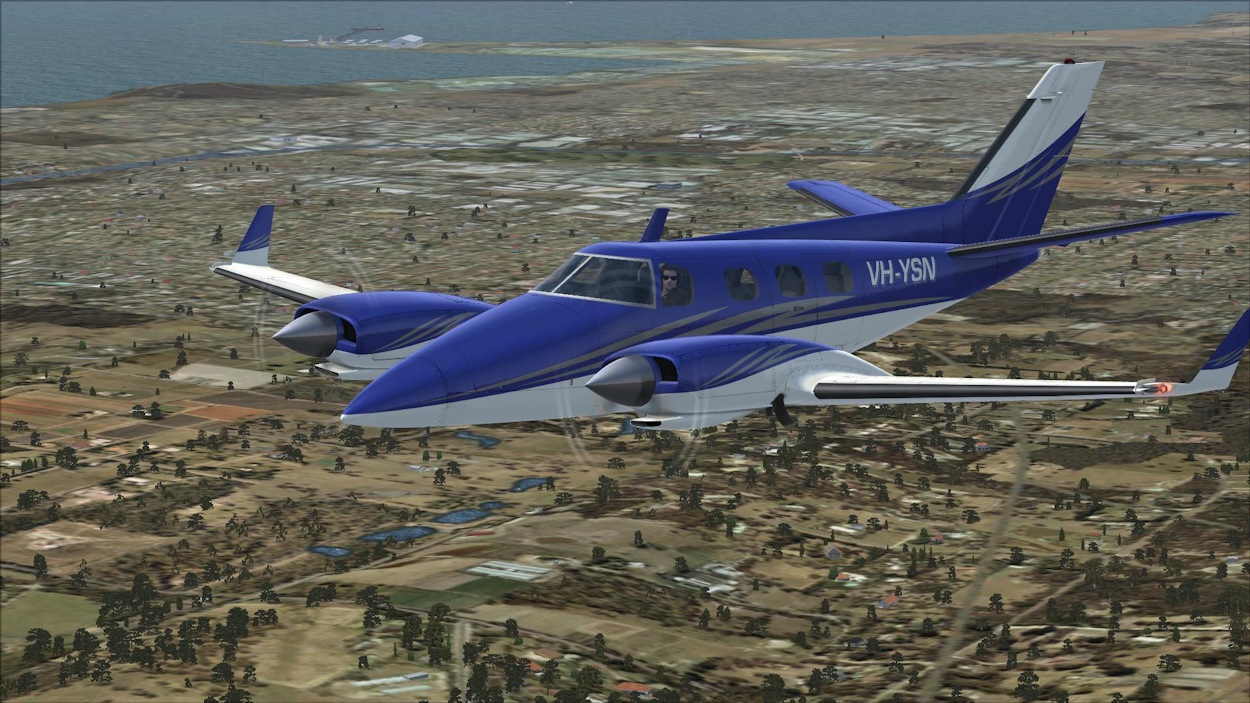 Just Cruising |
With a full avionics suite, the Beechcraft Model 60 ‘Duke’ is a classic, general aviation tourer and RealAir have modelled the B60 'Duke' Version 2.0 to this end beautifully. The amount of effort and detail RealAir have put into the development of the 'Duke' is clearly evident. One of the first questions one asks when purchasing a new aircraft add-on is, "What features are included?", well, with the RealAir 'Duke' Version 2.0, the question is, "What features are not included?". RealAir have delivered an aircraft which provides a total flying experience whilst still retaining the fun of flying.
Like other aircraft in the RealAir stable, the 'Duke' Version 2.0 is another perfect case for “read the manual”. Of course, you can just take to the skies, but chances are you will miss some of the finer detail and experiences to be had with the features of this aircraft. This review has included over 25 hours of specific review and flight testing flying hours and there are still small nuances I am discovering about this aircraft each time I take it up. The Flying Guide and Frequently Asked Questions documentation are a "must read" at some point.
The model features listed by RealAir Simulations for the 'Duke' Version 2.0 are some of the most extensive range of features for this category of aircraft this reviewer has seen in over 25 years of flight simming experience. The 'Duke' Version 2.0 is not just a simple makeover and the list of major updates and improvements reflects the level of accuracy, detail, and quality which RealAir have put into the additional development of this aircraft over the original. The list includes:
● high definition 2048 pixel textures;
● exterior 3D model and texture enhancements;
● major update to the virtual cockpit modelling and textures, including a more detailed cabin and higher resolution textures on the panels,
providing improved detail and clearer panel labels;
● more character and ambience in the cockpit textures, including dust and minor wear marks, with subtle details revealed as sunlight moves
across the cockpit;
● custom sounds and animations designed to breathe life and character into the 'Duke';
● custom sounds on all cockpit switches, table, doors, armrests, etc.;
● extensive custom camera animations simulating engine and ground vibration, overspeed and stall buffet, propeller torque reaction,
landing forces, etc., with extensive custom sounds designed to enhance the custom camera effects;
● new exterior liveries;
● five new panel and cabin colour schemes;
● 3D model and texture performance optimisation to ensure performance similar to the previous version, despite the much higher texture
resolution;
● multiplayer performance optimisation to allow for good performance, and trouble free flying in multiplayer;
● extensive flight model improvements;
● improved, more realistically sized gauges with dust, dirt and finger marks on gauge glass (with the option of hiding these dust and
dirt marks);
● improved gauge lighting;
● 3D lights in exterior and VC views;
● 3D landing lights with custom runway light splash;
● completely reworked VC night lighting;
● improved click spots and the option to disable them for EZDOK camera and Track IR users;
● an option to keep the VC textures in memory for a smoother and faster transition between cockpit and exterior views;
● optional suspension and touchdown sounds for both hard and soft FSX runway surfaces;
● engine icing improvements;
● ADF dip simulated (user selectable);
● 3D blurred propellers;
● flap buffet animation (flaps gently vibrate when lowered);
● optional flap failure when safe flap operating speeds are exceeded;
● improved cockpit door animation - the door closes with speed, and gently buffets if not properly latched and wind roar can be heard when
the door is open and the engines are turning, even while parked;
● overspeed flutter animations on the ailerons and yoke, with accompanying sounds; and
● landing touchdown camera effect - an advanced touchdown thump effect which reacts to the smoothness of the landing, so, if you ‘grease’
the landing, you will see almost no camera movement, whereas if you thump the 'Duke' down hard while side slipping you will see an
appropriately large movement from the viewpoint camera. This feature can also be disabled via the Config Panel.
There is a single model provided for the 'Duke' Version 2.0 and, across the range of aircraft paint schemes, it is also represented with and without winglets.
Visual Appearance
Paint Schemes. There are five individual HD paint schemes provided with the 'Duke' Version 2.0, and each aircraft has a unique aircraft registration number and a unique colour matched interior. The surface textures, reflections, and shadings give the aircraft a crisp and realistic appearance. A paint kit is available for separate download from the RealAir Simulations web site for aircraft painting enthusiasts.
 Paint Scheme 1 |
 Interior Scheme 1 |
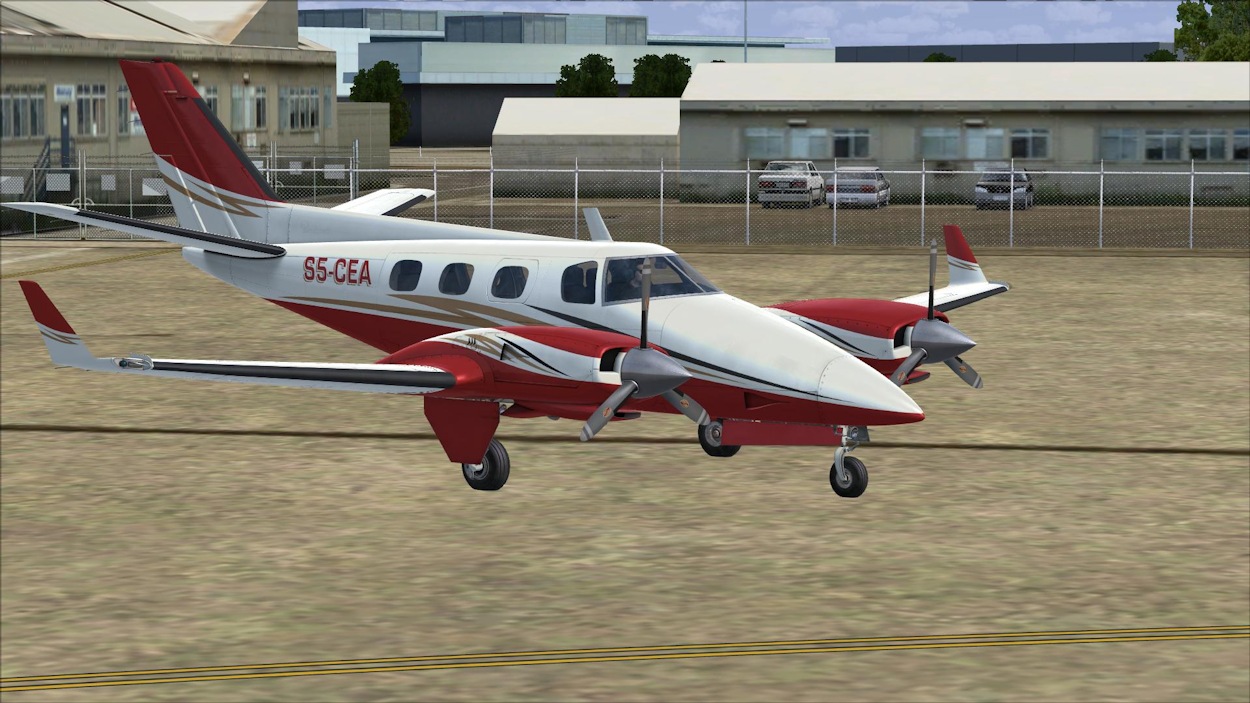 Paint Scheme 2 |
 Interior Scheme 2 |
 Paint Scheme 3 |
 Interior Scheme 3 |
 Paint Scheme 4 |
 Interior Scheme 4 |
 Paint Scheme 5 |
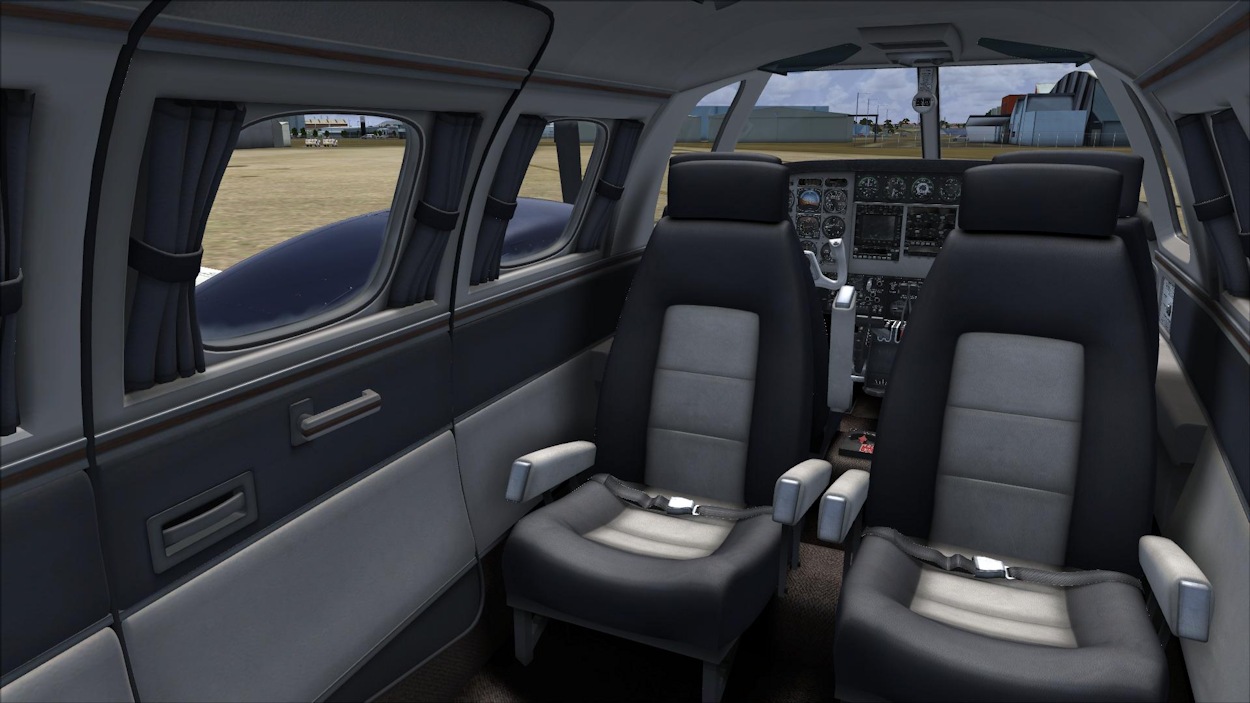 Interior Scheme 5 |
Livery Expansion Pack. The free Livery Expansion Pack, available as a separate download after purchase, provides an additional five HD paint schemes, each, again, with a unique aircraft registration number and a unique colour matched interior.
 Livery Pack 1 |
 Interior Livery 1 |
 Livery Pack 2 |
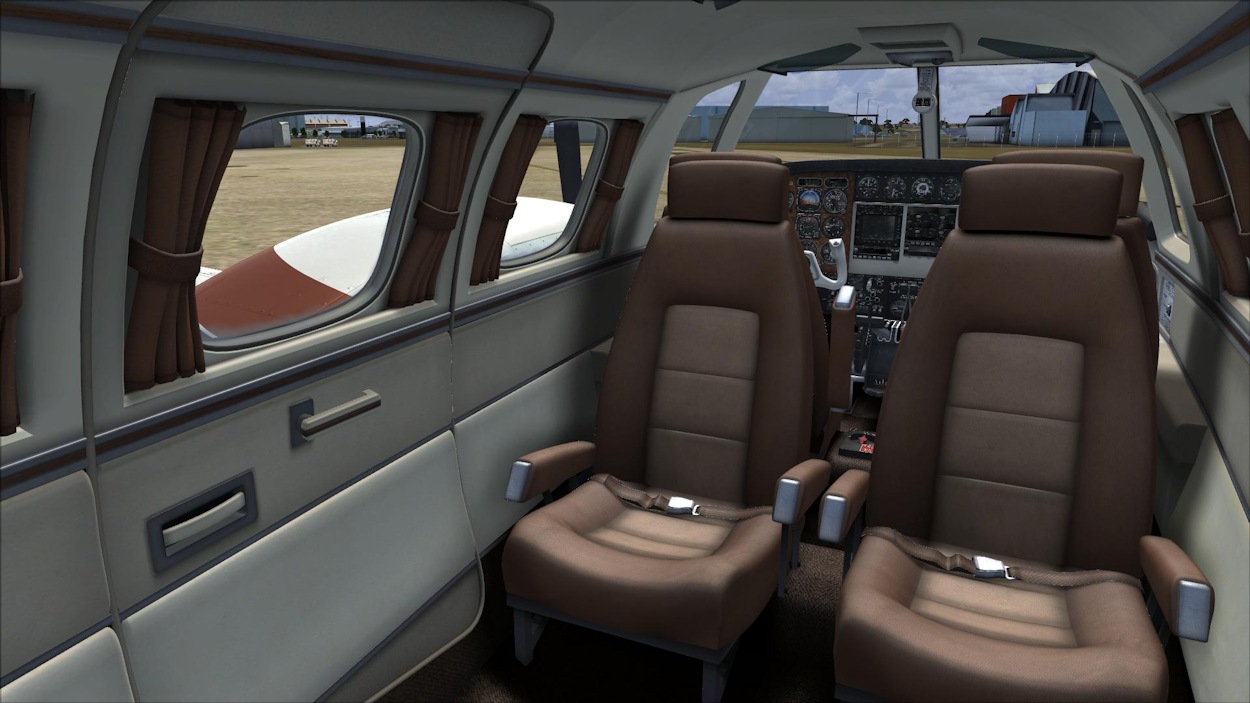 Interior Livery 2 |
 Livery Pack 3 |
 Interior Livery 3 |
 Livery Pack 4 |
 Interior Livery 4 |
 Livery Pack 5 |
 Interior Livery 5 |
Exterior. A trademark of RealAir Simulations is the very high level of attention to accuracy and detail in the exterior modelling of their aircraft and the 'Duke' Version 2.0 is consistent with this standard. The level of this detail includes individual fuselage panels, panel access handles, various aerials and antenna, fuel tank caps, cabin entrance foot step, static discharge wicks on the trailing edges of the wings, elevators, and rudder, and panel screws and rivets. The landing gear is highly detailed and engine exhaust and oil stains on the fuselage and wings add to the overall realistic appearance. A comparative review of photographs of real world aircraft to RealAir's rendition of the B60 'Duke' reveal the exterior shape and dimensions to be highly accurate and a true representation of the real world aircraft. A noted difference was the lack of the access window on the pilot's side cockpit window. Other noted differences were minor and are considered to be related to real world production variations and / or options.
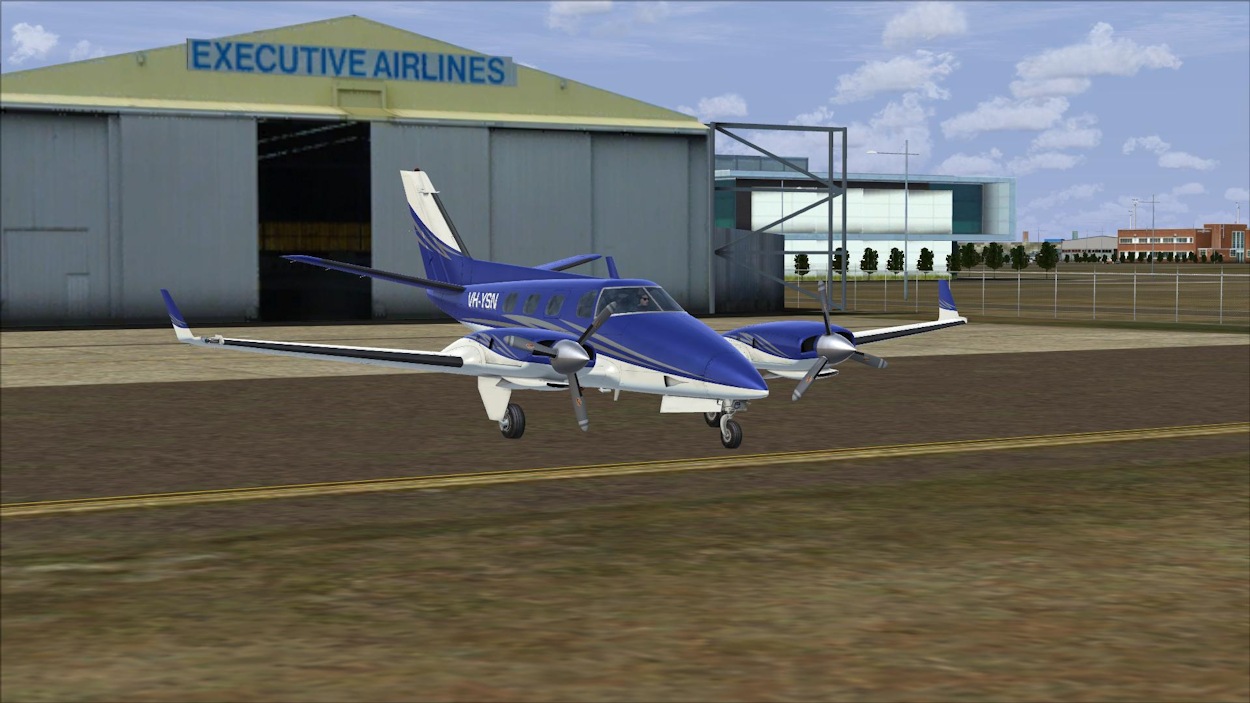 External General View |
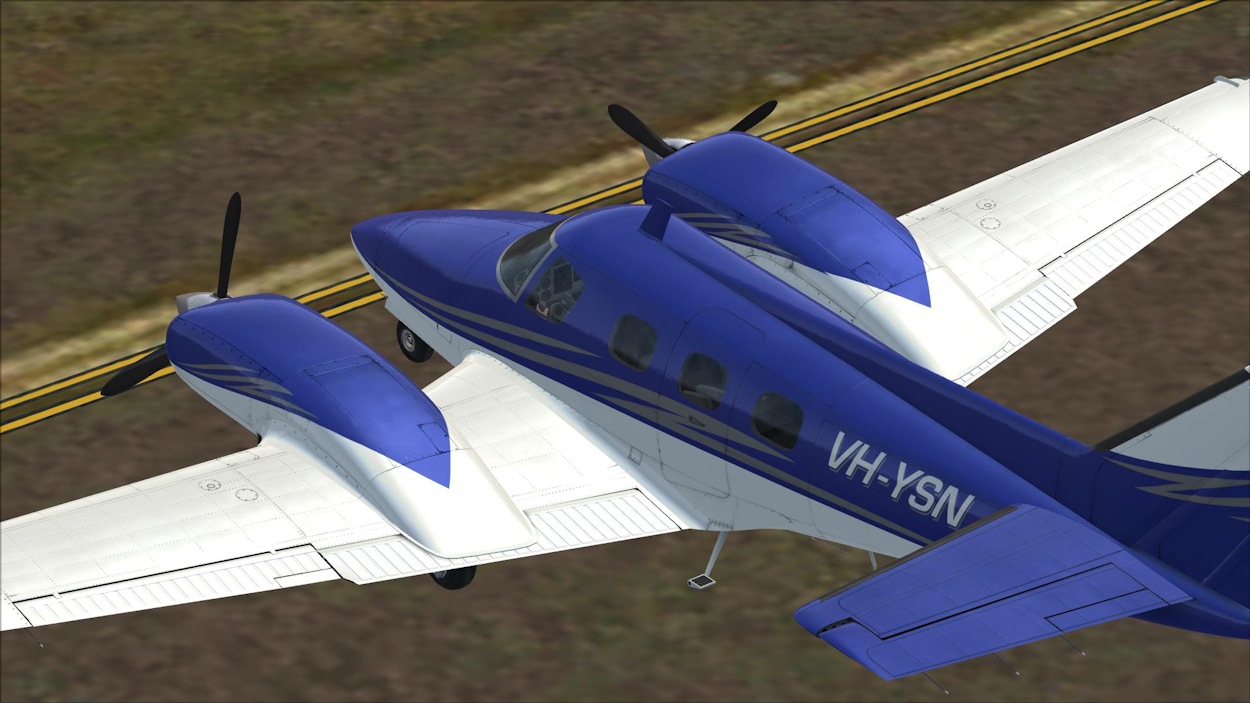 External Top View |
 External Nose View |
 External Rear View |
 Fuselage Underside 1 |
 Fuselage Underside 2 |
Interior. The general appearance of the interior of the 'Duke' Version 2.0 is also modelled to a high degree of detail and RealAir have done a credible job representing it when compared to real world layouts. The panel layout is very realistic and modelled to a high degree of accuracy, notwithstanding the various avionics fit out options available for the real world aircraft. Consequently, when compared to photographs of real world aircraft, I was unable to find one which exactly matched the panel layout modelled by RealAir. Nonetheless, the panel layout is certainly highly representative of the real world aircraft. The general cabin layout is far more generic though, and whilst the basic detail was represented, it lacked the finer detail.
Instrument Panel Layout. Primary flight instruments in the 'Duke' Version 2.0, including the DME and RMI, are replicated on both the left (pilot) side and right (co-pilot) side of the instrument panel. All engine management instrumentation, GPS, KFC 225 Automatic Flight Control System (autopilot), COM and NAV radios, ADF receiver, and transponder are located centrally. The throttle and trim controls are located on the throttle pedestal, which is located centrally, and the fuel tank selectors are located on the floor between the pilot and co-pilot seats. The de-ice switches, light switches, fuel gauges, landing gear lever, flaps lever, cabin pressurisation controls, climate control switches, and other ancillary gauges and switches are all located on the lower panel. Avionics power switches, battery and generator switches, fuel boost pump switches, ignition switches, Hobbs meters, and cowl flap switches are all located on a side panel to the left of the pilot. The primary flight instruments are laid out in the standard “T” and "six pack" arrangement and all the flight instruments are clear and easy to read and have the option for instrument glass reflections to be enabled or disabled. The removal of both yokes can be toggled to provide an unobstructed view of the panel, particularly the de-ice and light switches located on the lower panel. A Garmin GNS 530 GPS unit is represented on the panel, however, it only functions as a default FSX Garmin 500 GPS unit, with some buttons labelled incorrectly as a consequence. The standard FSX Garmin 500 GPS units is available as a panel window. The KFC 225 Automatic Flight Control System (autopilot) functions differently to the FSX standard Bendix/King units and deserves some brief attention to the manual to ensure correct operation. Various alternative cockpit camera views are available to provide more detailed views of the instruments. A full set of checklists and aircraft reference data is provided on the 'Kneeboard'.
 Virtual Cockpit View |
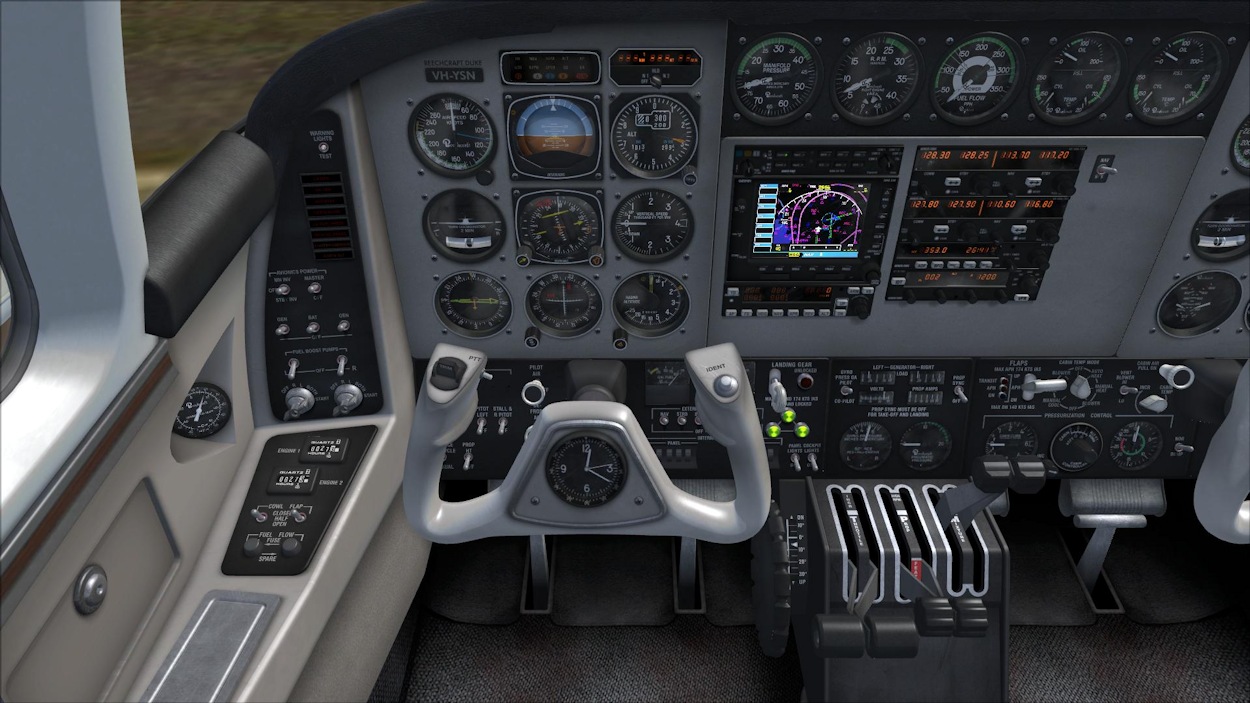 Pilot Detailed Panel View |
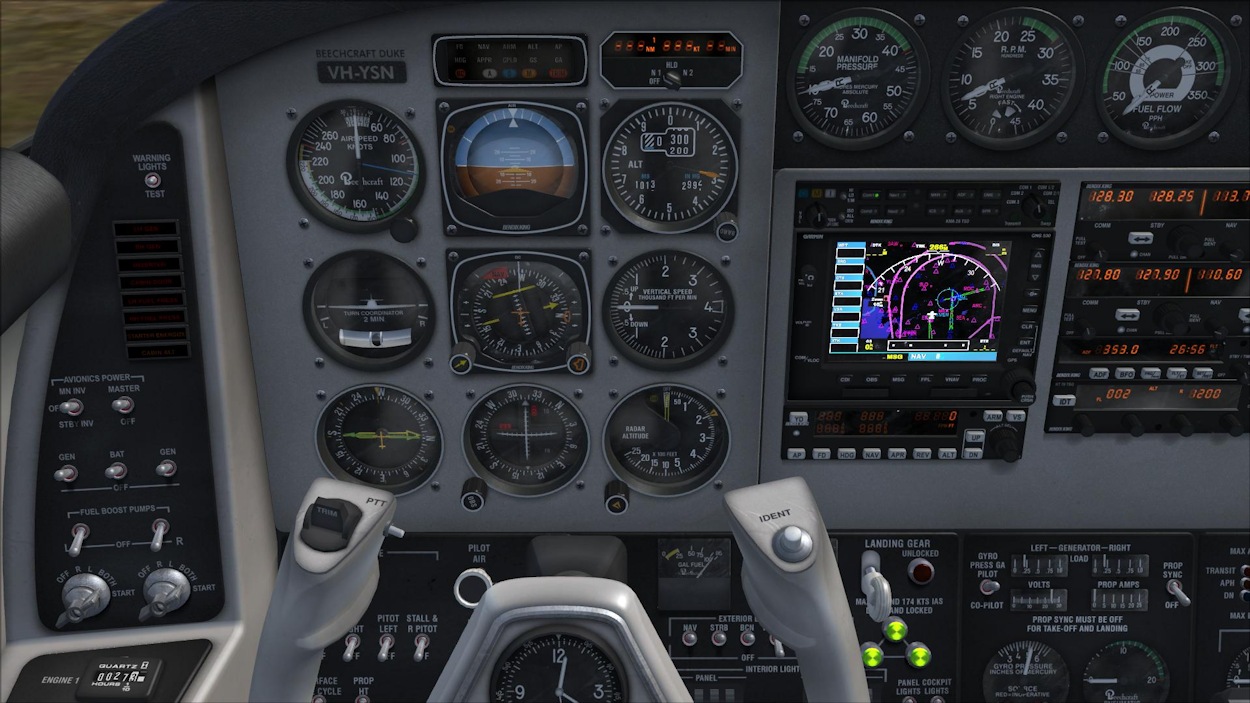 IFR View |
 Co-Pilot Detailed Panel View |
Cabin. The cabin of the 'Duke' Version 2.0 follows the standard six seat arrangement for this style of aircraft with a club seating configuration for the four rear seats. The reflections and various dirt, dust and smudge marks on the windows and instrument glass add a very realistic look and feel to the cabin and the tray table provides a nice touch to the rear cabin, when deployed. The detail in the textures of the seating, seatbelt webbing, and floor carpet provide a reasonably realistic appearance, but were lacking for the fine detail displayed in other areas. Overall though, the attention to detail in the cabin is of a high quality.
Animations
The animations of the primary and secondary control surfaces and other moving elements on RealAir's B60 'Duke' Version 2.0 are all modelled faithfully. A significant amount of design effort has gone into the animations and moving parts on RealAir’s B60 'Duke' Version 2.0 and it builds on animations developed for other aircraft in the RealAir stable. The 'Duke' Version 2.0 is packed with animations, both the obvious and the more subtle, and these really set this aircraft apart from your average general aviation aircraft add-on. The 'Duke' Version 2.0 has all the standard animations you would expect, but it is the more unique ones which demonstrate the depth and quality of the development effort in this area.
Animations include:
● primary control surfaces – ailerons (including aileron overspeed flutter), elevators, and rudder;
● secondary control surfaces – flaps (flap buffeting when lowered and on flap blow out); and
● others – retractable landing gear, landing gear suspension compression, airframe vibrations, landing touchdown thump effect, aileron,
elevator and rudder trim tabs, rolling wheels, cabin entrance foot step retract / deploy, cockpit door open / close (including door buffeting
when not fully latched), yoke overspeed flutter, cabin tray table, armrests, sun visors, and pilot head movement.
 Landing Gear |
 Landing Gear Retracting |
The unique animations on the 'Duke' Version 2.0 are exceptional and something to behold. These animations include:
● airframe vibrations;
● landing touchdown thump effect;
● flap buffeting when the flaps are lowered;
● flap buffeting when there is a flap blow out caused by lowering the flaps above the designed flap maximum extension speed (VFE);
● overspeed flutter on the ailerons and yoke; and
● cockpit door which, if left open, will slowly close as speed increases and then buffet in the propeller wash and slipstream.
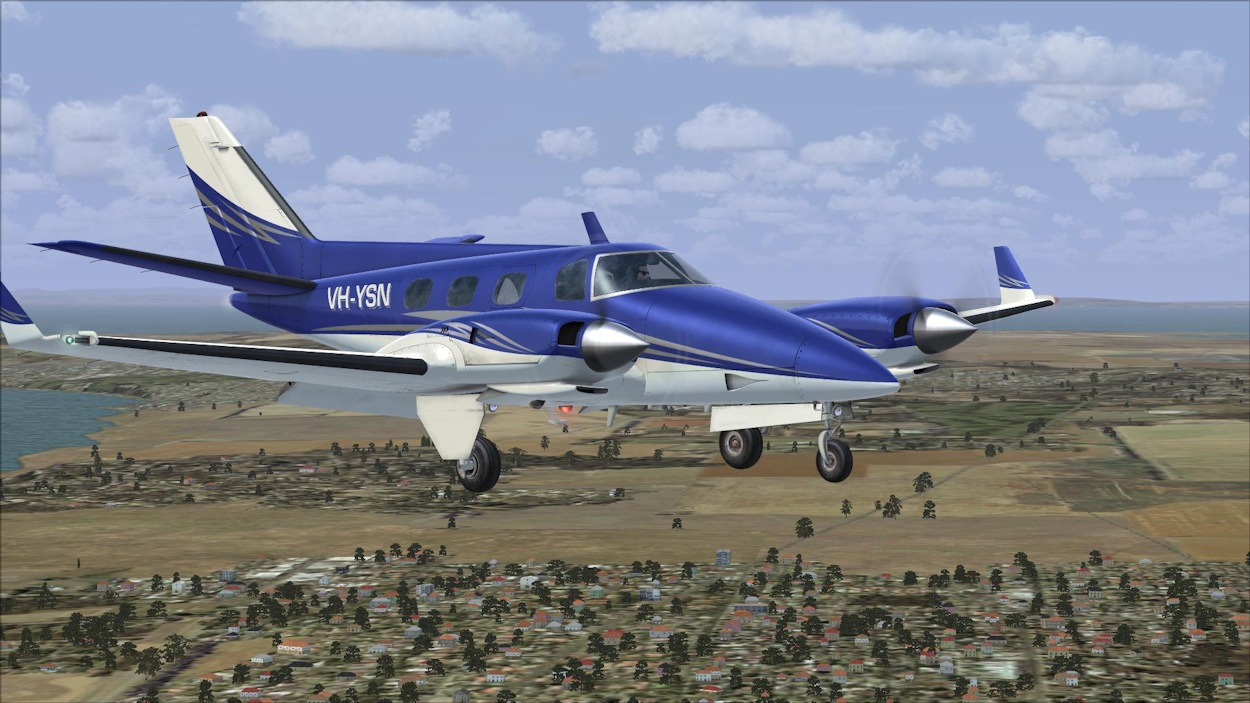 Landing Configuration 1 |
 Landing Configuration 2 |
The airframe vibrations provide a very realistic flying experience. Every subtle change during engine start up and shut down, engine throttle or RPM changes whilst on the ground, and gear and flap deployment have a “bump” or “shudder” animation that is so unique. The gauge needles vibrate when the aircraft is idling on the ground and they also respond to ground roll vibrations and the compression of the gear suspension under braking and over rough surfaces. The compression of the gear suspension is “felt” from inside the cockpit. Whilst braking or during a ground roll over a rough surface, the “Outside View” provides a clear indication of how the aircraft reacts at different times and on different surfaces. The cockpit door, when opened in flight, does not open fully but responds to the propeller wash and slipstream with a buffeting effect.
The tray table in the rear cabin can be deployed and stowed by clicking on the click spot and selected armrests can be raised and lowered by also clicking on the respective click spots. The sun visors can be lowered into place, and various cabin conditioning and temperature controls are operable, these being for affect only. Another minor observation relates to the static discharge wicks on the trailing edge of the wings, elevators, and rudder. Unfortunately, the movement of these in the airflow is not animated. With the other detailed animations, I thought this feature could also have been included.
Lighting
RealAir have done a credible job on the lighting and lighting effects on the 'Duke' Version 2.0 and have faithfully reproduced a highly realistic representation of the real world aircraft. In particular, the custom 3D lighting effects for all external lights and the virtual cockpit are excellent and the 3D landing lights and taxi light produce a very realistic lighting effect on the ground. The detailed night light effects for the instrument panel are quite exceptional and replicate beautifully the night lighting seen in photographs of real world aircraft. All interior lighting affects can be seen when viewing the aircraft from an external view.
 Pilot Detailed Panel View, Night |
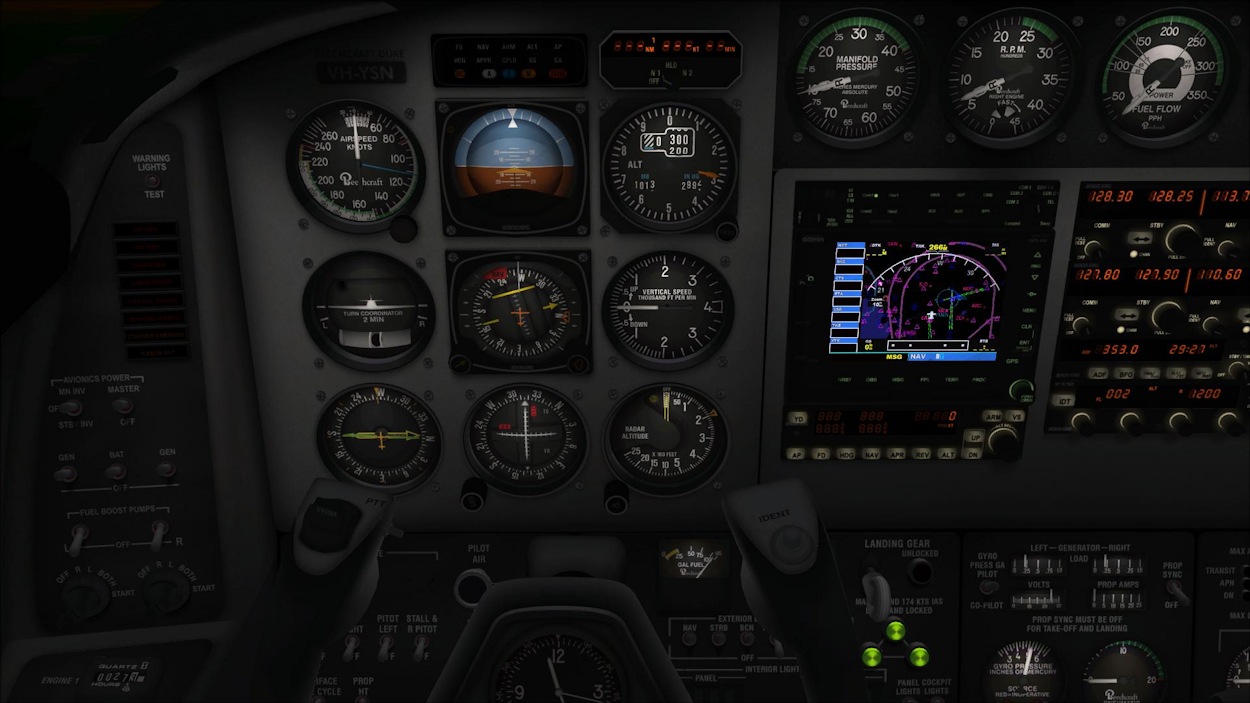 IFR View, Night |
Sounds
The sounds on RealAir’s ‘Duke’ Version 2.0 are incredibly realistic and representative of the real world aircraft. This is a major feature of the ‘Duke’ Version 2.0 and provided by the "RealView" Advanced Sound Effects. This is a comprehensive collection of sound effects which cover nearly every sound aspect of the operation of the aircraft. Every subtle change in the engine from start-up to shut-down, throttle, RPM and fuel mixture changes have a distinctive sound associated with it. The sounds of the gear and flaps during their respective deployment and retraction phases are extremely realistic with the buffeting effects and wind sounds during different flight manoeuvres adding further to the realism. When combined with the animations and cockpit detail, they provide a complete immersive flying experience. Other typical sounds include the various knob and switch sounds. In addition to this, the stereo separation in the sound provides for a consuming, all round experience.
General Characteristics and Performance Specifications
The general characteristics and performance specifications for the Beechcraft B60 'Duke' are provided in the table. This is based on data from the Beechcraft web site, data in the documentation provided by RealAir, and general research sources. Some of this data varies between sources and also may be an approximation due to variances in data and the specific aircraft modelled by RealAir.

Flight Performance
A specific Test Flight was conducted from Essendon (YMEN) to Innisfail (YIFL) to test the flight performance of RealAir's B60 'Duke' Version 2.0. The flight was conducted in clear weather with a full fuel load, the aircraft at maximum take-off weight (MTOW), and the route distance was approximately 1,211 nm. The route was particularly chosen to provide a basis upon which to test the range characteristics of the 'Duke' Version 2.0. Like most aircraft of this type, adjustments must be made to fuel / pax loading to remain within the MTOW limitations.
A cruise altitude of 20,000 feet was adopted on the Test Flight. During cruise, a 45% power setting was established with a manifold pressure setting of 23.0 inHg and an rpm setting of 2400 rpm. The mixture setting was leaned out to produce a total fuel flow rate for both engines of approximately 24.3 gph. The cruise setting produced an average speed of 161 knots true air speed (KTAS) for the flight and on shut down on the ramp at YIFL, there was 14.8 gallons of fuel remaining in the tanks. There was a slight performance variance compared to the Flight Performance tables provided by RealAir. The Flight Performance tables indicate the performance settings, as used in the Test Flight, should have produced a fuel flow rate of approximately 27.7 gph. However, the impact of this variance is considered minimal.
The Test Flight confirms the modelling of the aircraft for range performance to be highly accurate. The detected variance on the fuel flow rate is minimal and does not significantly impact the range performance of the 'Duke' Version 2.0.
The aircraft was easy to taxi. With 0° flaps, aircraft rotation occurred at approximately 95 knots indicated air speed (KIAS) and the aircraft easily maintained a normal climb speed of approximately 140 KIAS at a rate of climb consistent with the performance parameters for the aircraft, allowing for some adjustments. Even at MTOW, the 'Duke' Version 2.0 climbed effortlessly. Just after take off, the aircraft also displays the characteristic yaw to the left as the torque factor of the engines takes full affect. With land gear down, full flaps, and the engines at idle, the aircraft stalled at approximately 75 KIAS.
At MTOW, the aircraft would not climb to the service ceiling altitude, the maximum achieved being 27,500 ft before the aircraft stalled. After reducing the take off weight to 6,000 lb, and with the obviously required adjustments to the rate of climb, the aircraft was able to climb to this altitude, however, it was close to the stall speed. Configured for landing, with full flaps and trimmed for a descent rate of approximately 500 ft/min, the aircraft’s approach speed was approximately 100 KIAS and it touched down at approximately 85 KIAS, with a landing roll out comparable with the specifications for the B60 'Duke'.
In testing the accuracy of the instruments, based on the measured Test Flight, the speed indications on the airspeed indicator and the DME, were consistent with the averages measured. Additionally, when establishing a set rate of climb on the vertical speed indicator, the respective gain in altitude on the altimeter was achieved within the measured minute, and a standard rate turn was achieved within the measured two minute period using the turn coordinator. However, there was no detectable gyro drift. Even after reinstalling the aircraft and making various adjustments to the FSX Realism settings and the settings in the Duke V2 Config Panel application, this situation was not resolved.
In all, the performance of RealAir's B60 'Duke' Version 2.0 was excellent in flight, displaying the typical flight characteristics of this aircraft. Overall, the aircraft model displays a very accurate rendition of the flight characteristics and performance of the real world aircraft, with only minor anomalies detected.
Technical Requirements
The RealAir B60 'Duke' Version 2.0 is for FSX only. Other technical requirements are as follows:
● Windows Vista or Windows 7 (32bit or 64bit);
● Microsoft Flight Simulator FSX with SP1 and SP2 (or Acceleration Pack) installed; and
● Pentium V, 2GHz or similar, 2GB RAM, 512MB graphics card, and 779MB available HDD space.
Simulator Performance
The aircraft model performed excellently within the existing settings I have in FSX. I have most of my settings set very high and there was no need to make any adjustments. FSX continued to perform smoothly and as it would with any default aircraft.
Review Computer Specifications
The specifications of the computer on which the review was conducted are as follows:
● Intel i7 990X Extreme 3.46GHz;
● NVidia GTX580, 1536MB graphics;
● 12GB Kingston DDR3 2000MHz;
● Windows 7, (64bit);
● Microsoft Flight Simulator FSX Acceleration; and
● additional major add-ons include: REX Essential Plus Overdrive; Ultimate Traffic 2; Orbx FTX Global BASE; Orbx FTX Global VECTOR; Orbx
FTX region series; and Orbx FTX airport series.
Conclusion
RealAir Simulations have gone to great lengths to refine or improve virtually every aspect of the model in the B60 ‘Duke' Version 2.0. They have created an aircraft of high accuracy and detail which displays exceptional flight characteristics and realism. With its complex flight model, and fast, high altitude performance, the B60 ‘Duke' Version 2.0 is a beautiful cross country tourer which provides a high level of immersive experience whilst still retaining the fun of flying.
Detected issues were minor and do not impact or significantly detract from the general flying of the aircraft. If you are a general aviation and / or Beechcraft fan in particular, you will want to add this aircraft to your collection.
Verdict
The B60 ‘Duke' Version 2.0 is another excellent product from RealAir Simulations which displays high accuracy and detail, excellent flight characteristics and realism, and represents exceptional overall value for money.
Overall:
External Model – 9.5 / 10
Internal Model – 9.0 / 10
Flight Characteristics (does it fly by the numbers) – 9.5 / 10
Flight Dynamics (does it feel like what it looks like) – 10 / 10
Sounds – 10 / 10
Documentation – 10 / 10
Value for Money – 10 / 10
Pros:
High quality.
Comprehensive and realistic modelling and performance.
Realistic flight characteristics.
Realistic and comprehensive sounds.
Excellent documentation.
Excellent value for money.
Cons:
Discrepancy with represented GPS.
Generic appearance of the rear cabin.
Minor performance variances.
Product Link: Duke B60V2
| Rating: |
 |
|
| • External Model: | 9.5/10 | |
| • Internal Model: | 9.0/10 | |
| • Sounds: | 10/10 | |
| • Flight Characteristics (does it fly by the numbers): | 9.5/10 | |
| • Flight Dynamics (does it feel like what it looks like): | 10/10 | |
| • Documentation: | 10/10 | |
| • Value for money: | 10/10 |
| The RealAir B60 'Duke' Version 2.0 is awarded an overall Mutley’s Hangar score of 9.7/10, "Outstanding" and a Mutley's Hangar Gold Award. |
.jpg)

